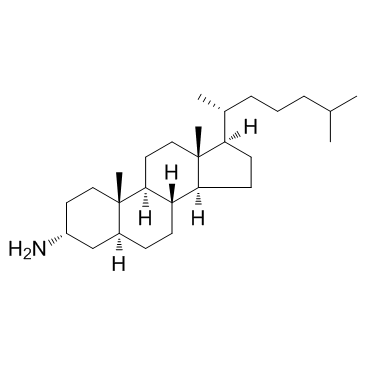3α-Aminocholestane
Modify Date: 2024-01-08 00:25:54

3α-Aminocholestane structure
|
Common Name | 3α-Aminocholestane | ||
|---|---|---|---|---|
| CAS Number | 2206-20-4 | Molecular Weight | 387.68466 | |
| Density | N/A | Boiling Point | N/A | |
| Molecular Formula | C27H49N | Melting Point | 104.5-105.5℃ (methanol ) | |
| MSDS | N/A | Flash Point | N/A | |
Use of 3α-Aminocholestane3α-Aminocholestane is a selective SH2 domain-containing inositol-5′-phosphatase 1 (SHIP1) inhibitor with an IC50 of ~2.5 μM. |
| Name | Cholestan-3-aMine, (3α,5α)- |
|---|---|
| Synonym | More Synonyms |
| Description | 3α-Aminocholestane is a selective SH2 domain-containing inositol-5′-phosphatase 1 (SHIP1) inhibitor with an IC50 of ~2.5 μM. |
|---|---|
| Related Catalog | |
| Target |
IC50: 2.5 μM (SHIP1)[1] |
| In Vitro | OPM2 cell viability is effectively reduced by 3α-Aminocholestane (3AC) treatment. RPMI8226 and U266 cells show significantly less sensitivity to 3α-Aminocholestane treatment when compare with OPM2 cells, although viability is decreased significantly at concentrations of ≥12.5 μM. Treatment with 3α-Aminocholestane for 36 h severely reduces the percentage of cells in the S phase, which is accompanied by an increase of cells in the G2/M phase. In contrast, in the less proliferative RPMI8226 and U266 cells, cell cycle progression is blocked in the G0/G1 phase upon 3α-Aminocholestane treatment, in conjunction with a reduced percentage of cells undergoing the S phase[2]. |
| In Vivo | It is found that 3α-Aminocholestane (3AC) results in reduced multiple myeloma (MM) growth in vivo, as determined by quantitation of free human Igλ light chain in the plasma after OPM2 challenge. In addition, reduced numbers of circulating OPM2 cells, as determined by human HLA-ABC staining, is observed in peripheral blood from 3α-Aminocholestane-treated mice compare with vehicle controls. Most importantly, 3α-Aminocholestane treatment results in significantly enhanced survival of mice after tumor challenge. In 3α-Aminocholestane-treated mice that resist treatment, it is found that MM tumors exhibit an upregulation of SHIP2, reminiscent of in vitro treatment of OPM2 cells and suggesting that SHIP1 inhibition may select for tumor cells with increased SHIP2 expression[2]. |
| Cell Assay | Cells are treated in triplicate or more with increasing concentrations of compounds (including 3α-Aminocholestane). Cell viability is determined with a Cell Counting Kit according to the manufacturer’s instructions. The odds density (OD) of compound (including 3α-Aminocholestane )-treated cells is divided by the OD of their vehicle control, and the viability is expressed as a percentage of untreated cells. Results are expressed as mean±standard error of the mean (SEM) of three individual experiments. For phosphatidyl inositol phosphates (PIP) add-back experiments, MCF-7 cells are treated for 2 h with 10 μM SHIP inhibitors (including 3α-Aminocholestane ), after which cells are washed and fresh medium is added. Cells are subsequently cultured in the absence (0 μM) or presence (10 or 20 μM) of either PtdIns(3,4)P2-diC16 (P-3416) or PtdIns(3,5)P2-diC16 (P-3516) for 36 h, after which cell viability is determined by the Cell Counting Kit[2]. |
| Animal Admin | NOD/SCID/γcIL2R (NSG) mice are injected intraperitoneally with 1×107 OPM2 cells and 6 h later receive an initial injection of 3α-Aminocholestane (3AC) or vehicle. 3α-Aminocholestane is suspended in a 0.3% Klucel/H2O solution at 11.46 mM and administered by intraperitoneal injection of 100 μL solution. Vehicle-treated mice receive 100 μL injection of 0.3% Klucel/H2O solution. The mice are then treated with 3α-Aminocholestane or vehicle daily for the next 6 d and then twice per week in the remaining 15 wks of the survival study[2]. |
| References |
| Melting Point | 104.5-105.5℃ (methanol ) |
|---|---|
| Molecular Formula | C27H49N |
| Molecular Weight | 387.68466 |
| Storage condition | 2-8℃ |
| 3α-Aminocholestane |